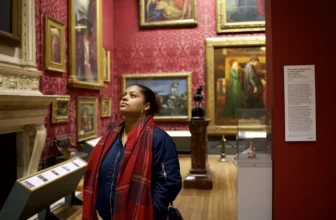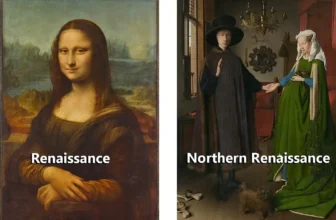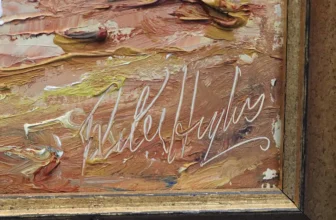Meaning of George Stubbs’ Lion Attacking a Horse Painting
In the annals of art history, there are paintings that dazzle with their beauty, others that evoke serenity or religious devotion. Then there are paintings that strike at the primal heart of existence, paintings that refuse to be ignored, haunting, kinetic, and alive. George Stubbs’ Lion Attacking a Horse is one such masterpiece. First painted in 1762, it has since gripped generations of viewers with its raw emotional power and visceral realism. But what lies behind this violent image? What did George Stubbs intend to convey when he created a scene of such primal intensity, and what does this painting continue to say to us centuries later?
The Artist Behind the Canvas: George Stubbs
To understand the painting, one must first know the man who created it. George Stubbs (1724–1806) was an English painter most renowned for his anatomical precision and depictions of horses. In the 18th century, when portraiture and pastoral landscapes reigned supreme in British art, Stubbs carved out a unique niche by turning his keen scientific mind toward the study of animals.
Born in Liverpool, Stubbs had no formal artistic training. Instead, he taught himself anatomy by dissecting animals, most famously horses, and illustrating what he saw. This dedication culminated in his seminal publication The Anatomy of the Horse (1766), a scientifically rigorous and beautifully illustrated volume that revolutionized equine art.
Stubbs was, above all, an artist obsessed with truth, biological truth, emotional truth, and the violent truths of nature. And nowhere is that obsession more evident than in Lion Attacking a Horse.
The Birth of a Masterpiece: How Lion Attacking a Horse Was Painted
Stubbs painted the first version of Lion Attacking a Horse around 1762. Several iterations followed, each slightly different in tone and composition. What all versions share is the essential scene: a lion, claws unsheathed, jaws agape, leaps onto a rearing horse, its hooves flailing and eyes wide with terror.
The process behind the painting was as meticulous as it was innovative. Having already dissected and studied horse anatomy in exhaustive detail, Stubbs turned his attention to the lion, a creature less familiar in 18th-century England. Lions were exotic, symbolic beasts of Africa and Asia, and access to live specimens was rare. Nevertheless, Stubbs was granted permission to study and sketch a dead lion at the Tower of London’s Royal Menagerie. There, he observed not only the physical structure but imagined the behavior and dynamism of the animal in motion.
Unlike his contemporaries, who often stylized or romanticized animals, Stubbs sought realism, even when the subject was terrifying. He staged clay models and likely used live horses as references to capture the precise biomechanics of their reactions. The result is a painting with such visceral realism that it feels like a frozen moment torn from nature’s script, one of death, fear, and survival.
What Is Lion Attacking a Horse All About?
At first glance, the painting is literal. It depicts a lion attacking a horse, a brutal scene of predation, a snapshot of the natural order where the predator dominates the prey. But Stubbs, a man of the Enlightenment and deep philosophical thought, was never content with mere representation.
Lion Attacking a Horse is not simply zoological illustration, it is a drama, a theatre of existential conflict. The horse, often seen in Western art as a symbol of nobility, civilization, and man’s control over nature, is here reduced to prey, helpless and afraid. The lion, representing untamed wildness and primal power, becomes a symbol of chaos, of fate, and perhaps even death itself.
Through this interplay, Stubbs offers a meditation on the fragility of life and the inevitability of mortality. It’s a tragic ballet where beauty and horror coexist, and where no intervention, human or divine, will save the day.
Symbolism and Meaning in Lion Attacking a Horse
Though there is no written explanation by Stubbs detailing the symbolic content of this painting, art historians and critics have long interpreted it through multiple lenses, mythological, psychological, political, and existential.
1. Nature Red in Tooth and Claw
The most immediate reading of the painting is that it illustrates the cruelty of the natural world, Darwinian before Darwin. The lion is nature’s violence incarnate. The horse’s wide eyes, flaring nostrils, and frantic limbs scream with a raw emotion that contradicts the Enlightenment ideal of nature as ordered and benevolent.
Stubbs challenges the viewer to confront the uncomfortable truth: life is not always serene or noble. Sometimes it is chaotic, painful, and without mercy.
2. Civilization vs. Wilderness
The horse, long a symbol of refined elegance and domestication, represents civilization, man’s attempt to order the world. The lion, by contrast, is the wilderness, indomitable, fierce, and indifferent. Their clash evokes the eternal tension between culture and chaos, between rationality and instinct.
3. Psychological Allegory
Some scholars have suggested that the painting serves as a metaphor for inner psychological turmoil. The lion may be seen as a symbol of unconscious urges, primal fear, or the darker elements of the human psyche, while the horse represents conscious thought, rationality, or the ego under siege.
In this light, the painting becomes a visual depiction of internal struggle, emotion attacking reason, terror overwhelming calm, the shadow consuming the self.
4. Political and Colonial Readings
Others have interpreted the painting in the context of 18th-century British imperialism. The lion, often used in British heraldry, could represent imperial power or aggression. The horse, sometimes associated with foreign lands, freedom, or indigenous peoples, might then symbolize those subjected to colonial domination. If this was Stubbs’ intention, the painting takes on a provocative and unsettling political tone.
What Is Happening in the Painting?
In the painting’s composition, the lion is perched on the horse’s back, its claws digging deep into flesh. The horse, in a desperate attempt to escape, rears up on its hind legs. Every muscle is taut, every line drawn with stunning anatomical precision. The lion’s powerful jaws are open, fangs bared, as if about to deliver a fatal bite.
There is no background clutter, only a rocky, desolate landscape beneath and an ominous sky above. The scene is suspended in time, as if nature itself holds its breath. The intensity of the moment is heightened by the contrast between the flowing lines of the horse’s form and the angular aggression of the lion’s attack.
The viewer is not merely an observer; they are drawn into the horror and helplessness of the scene. The painting does not resolve itself, it offers no clear conclusion. Has the horse escaped? Will it die? Is this the end or just the beginning of the struggle?
What Type of Art Is Lion Attacking a Horse?
Lion Attacking a Horse defies simple categorization. It is not a traditional portrait or a landscape, nor does it belong strictly to religious or mythological genres. Rather, it occupies a unique space in 18th-century British art, blending scientific realism with romantic drama and symbolic overtones.
Art historians often classify it as:
Animalier Art – a genre dedicated to the realistic portrayal of animals.
Romanticism (Proto-Romanticism) – especially in its emotional intensity and focus on the sublime power of nature.
Natural History Illustration – due to Stubbs’ anatomical accuracy and scientific interest.
History Painting – not in the traditional sense of depicting historical events, but in the grand narrative style, portraying universal themes of struggle and mortality.
The painting prefigures the Romantic movement of the 19th century, particularly the works of artists like Théodore Géricault and Eugène Delacroix, who similarly explored the themes of animalistic power and emotional upheaval.
Where Is the Painting Today?
Over the years, multiple versions of Lion Attacking a Horse have been painted by Stubbs, and they reside in various prestigious collections.
The most famous version, painted in 1762, is held at The Yale Center for British Art, in New Haven, Connecticut. This oil-on-canvas is celebrated for its dramatic intensity and fine anatomical detail.
Another important version is housed in Tate Britain, London. This version, dated around 1765, also demonstrates Stubbs’ evolving technique and deepening emotional expressiveness.
Additionally, some of Stubbs’ studies and related works can be found in private collections and occasionally surface in exhibitions or auctions.
These paintings continue to be the subject of exhibitions, scholarly papers, and public fascination, reinforcing their place in the canon of Western art.
Influence
Lion Attacking a Horse remains one of the most powerful and enduring images of animal conflict in art history. It influenced not only later artists, but also shaped popular perceptions of nature, fear, and beauty.
Stubbs’ ability to merge scientific observation with emotional resonance made him a pioneer. His work laid the foundation for future explorations into the natural world, not just as a collection of biological systems, but as a stage for metaphysical and existential drama.
In many ways, Lion Attacking a Horse feels modern even today. Its psychological depth, symbolic ambiguity, and formal mastery speak to audiences across centuries. It confronts us with questions we still ask: What is the cost of civilization? What lies beneath the surface of reason? Are we ever truly safe from the wild forces, both external and internal, that stalk us?
George Stubbs’ Lion Attacking a Horse is more than just a depiction of predator and prey. It is a vision of life’s rawest truths, fear, mortality, conflict, and survival. It represents a philosophical interrogation of humanity’s place in the natural order, all expressed through a scene that is as brutal as it is beautiful.
From the anatomical precision of the figures to the symbolic weight they carry, this painting is a masterpiece not just of technique, but of meaning. It invites us to stare into the eye of the storm, and perhaps, into the eye of the lion itself, and ask what it means to be both hunter and hunted in the drama of life.
Stubbs captured more than anatomy; he captured the soul of nature. And in Lion Attacking a Horse, that soul is wild, majestic, and terrifyingly real.




